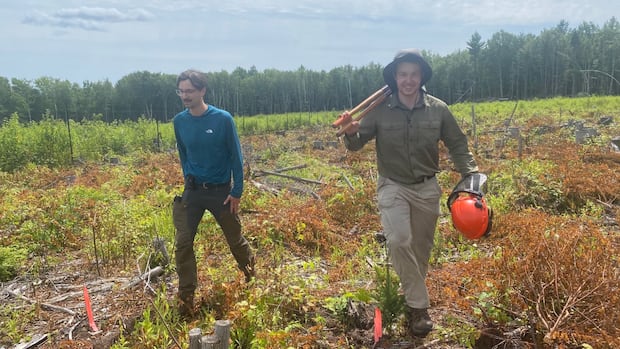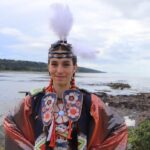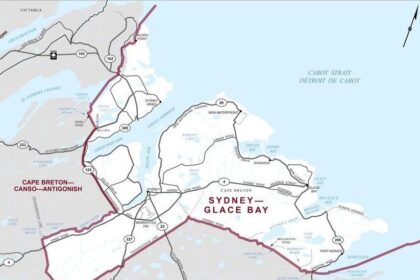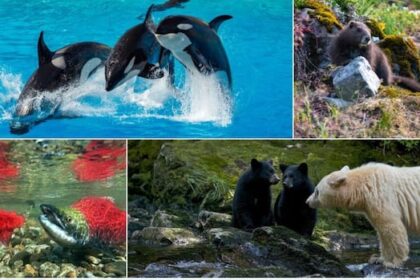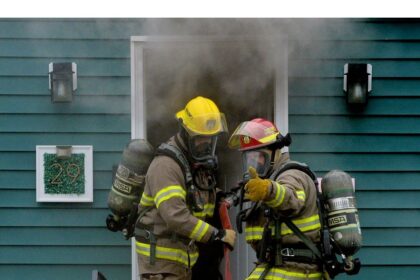Walking through an open field in the Acadia Research Forest north of Fredericton, you have to be careful where you step or you may crush one of Jacob Ravn’s “babies” — little white spruces that are a little over a year old and about 10 centimetres tall.Ravn, a PhD student, is part of a research team at the University of New Brunswick that’s in the early stages of a project to assess how the province’s trees will adapt to climate change.The research forest is one of 10 sites in Eastern Canada and the Northeastern U.S., and they hope what they learn will help industry and the province grow the forests of the future, says Ravn.”These are genetically improved white spruce,” Ravn says, bending down to talk about a tree in the early stages of growth.WATCH | Why researchers are using a test site near Boston for New Brunswick’s future forests:Will N.B.’s cold-loving trees still thrive in a warming climate? Researchers look to the futureClimate change could make forests of the future very different from what we know today. Researchers at the Acadia Research Forest north of Fredericton are working on a project that will assess how New Brunswick’s trees adapt to a warming climate.”We’re trying to understand how these [trees respond] to climate stress, and that will better inform industrial practices and hopefully reduce risk when it comes to planting trees or growing trees under [a] changing climate.”At its root, the project that includes provinces as far away as Ontario and states as far south as North Carolina, as well as 10 different tree species, is looking for the answer to a straightforward question.How would trees like the white spruce, a mainstay of the province’s lumber industry, adapt to a climate that continues to warm over the coming decades?The UNB team went to Amherst, Mass.s, earlier this year to plant trees for the TransX climate change project. (Submitted by UNB forestry department)A living labLoïc D’Orangeville, the project lead and a forestry professor at Université Laval in Quebec, says the right lab for this kind of research are forests in a warmer climate.”There’s an uncertainty in the climate projections for New Brunswick … but we’re looking at three- to four-[degree] warming in the coming decades,” D’Orangeville said. “So that gets us somewhere like Massachusetts in the coming decades. So the tree you’re planting today, you’re going to be harvesting it under the weather that you have in Boston.”Project lead Loïc D’Orangeville says the right lab for this kind of experiment is forested area in a warmer climate. (Zoom)D’Orangeville, who was a professor at UNB when the project started, said they’ve included 10 varieties of trees in the project. The softwood species are white pine, balsam fir, red spruce, black spruce and white spruce. The hardwood tree species are yellow birch, white birch, red maple, sugar maple and red oak.He says the boreal, softwood species that are characteristic of our cold northern climate with long winters may not fare well in the long run, whereas the ones that also grow in temperate climates may be fine.People working on the site where UNB researchers planted white spruce trees clear out pin cherry trees that could inhibit the growth of the young tree stand. (Mark Leger/CBC)The white spruce is one of those softwood trees that is vulnerable but a critical part of the forestry industry.”Can we intensively manage those boreal conifers and maintain them in the Maritimes despite climate warming? That’s one thing we’re going to be testing,” D’Orangeville said.But it’s difficult to predict how trees will respond to the changing climate, so he said they’re testing the adaptability of a number of them.”It’s better to have a diversity of species rather than just invest all in one, just like you’d invest your money not all in one startup, but rather diversify your portfolio,” he said.Seeds from the MaritimesGabriel Rogers, the site manager and a graduate of the environmental program in the UNB forestry department, says the trees planted at all the sites began as seeds in two nurseries run by the New Brunswick and Nova Scotia provincial governments: the Kingsclear Tree Nursery near Fredericton and the Strathlorne Forest Nursery in Cape Breton. They then spent a winter in a freezer at J.D. Irving Limited’s Juniper nursery to mimic dormancy, as if they were already in the ground.In the spring they were planted at the sites in Canada and the U.S., with the ones that travel south of the border needing to be inspected for potential diseases and pests.The TranX site is located in the Acadia Research Forest around 20 kilometres east of Fredericton. (Aniekan Etuhube/CBC)In the early years, they will focus on clearing vegetation that could threaten the young trees. At the Acadia site this summer, students were hired to get rid of an aggressive crop of pin cherries growing up around the white spruce.”If we didn’t cut them back and give [the spruce trees] that chance to out-compete the ingrowing vegetation, we’d likely see higher levels of mortality,” he said.They also have to put up fencing to protect them from deer and moose.Forests have rich diversityRogers, who focused on wildlife in his undergraduate degree, says these forests are not just sources of wood, but ecosystems in their own right.He says these woods are home to black bears, deer, moose, ground hogs, salamanders and birds like cedar waxwings. “If you [had] seen this place initially when it first got cut, you probably wouldn’t think it would be a biodiversity-rich area because it looks pretty harsh and like a moonscape,” he said. “But it’s quite jarring sometimes how much diversity you can find.”The study has a dual purpose, both informing forestry management practices that will help advance an important industry in the province and protecting the wildlife and trees that may have no commercial use.Gaetan Pelletier, the executive director of the Northern Hardwoods Research Institute in Edmundston, says the industry has to remain focused on what it can do now to address the changing conditions in the forests (Zoom)”It doesn’t have to be solely for industry benefit,” Rogers said. “You can take other things from what they learned from this project as well. For example, a species here … might not be as profitable for the industry or as commonly used economically, but it could still benefit the forest in some way or some species in the forest. So it’s still good to understand how that could be affected by climate change.”Over time, Ravn says they’ll be watching for how big the trees grow and the health of their foliage, as well as how they respond to wet and dry, and warm and cold conditions. “I stay in touch with my peers at all these different sites. Like, in the most northern site in Quebec, on top of a mountain that has snow even in late May to June, I’m always messaging them, ‘How are they looking? How are the trees? How are our babies?'”Acting now to improve resilienceGaetan Pelletier, the executive director of the Northern Hardwoods Research Institute in Edmundston, said the work of researchers like D’Orangeville is critical for long-term planning purposes. Gabriel Rogers and Jacob Ravn record measurements for a young white spruce tree planted in the Acadia Research Forest earlier this year. (Mark Leger/CBC)At the same time, he said, the industry has to remain focused on what it can do now to address the changing conditions in the forests, including droughts and diseases that affect key species of trees.”Our role is to look at what we do today to improve forest resilience, tree resistance, and grow a great mix of species and sizes and ages so that we can gradually learn and adjust,” he said.D’Orangeville says his team is a couple of years away from seeing preliminary results, and expects the information and insights will become better with time. It’s like good wine: These trials get better with age.— Loïc D’Orangeville”It’s like good wine: These trials get better with age,” he said. “The more time we wait, the better the information and knowledge. I’m hoping this will last for 10 to 15 years at least.”While D’Orangeville says they have to be patient waiting for results, he knows there’s a sense of urgency as the planet continues to warm. “Given the context of climate change, we need to make those changes happen,” he said.”But we need to know which changes are the right ones, and there are still big knowledge gaps. So if we can actually do good science and do some knowledge-based improvements to the way we manage our forests, that [would be a] huge success.”
How will Maritime trees fare as the province warms? Plant them down south and find out
